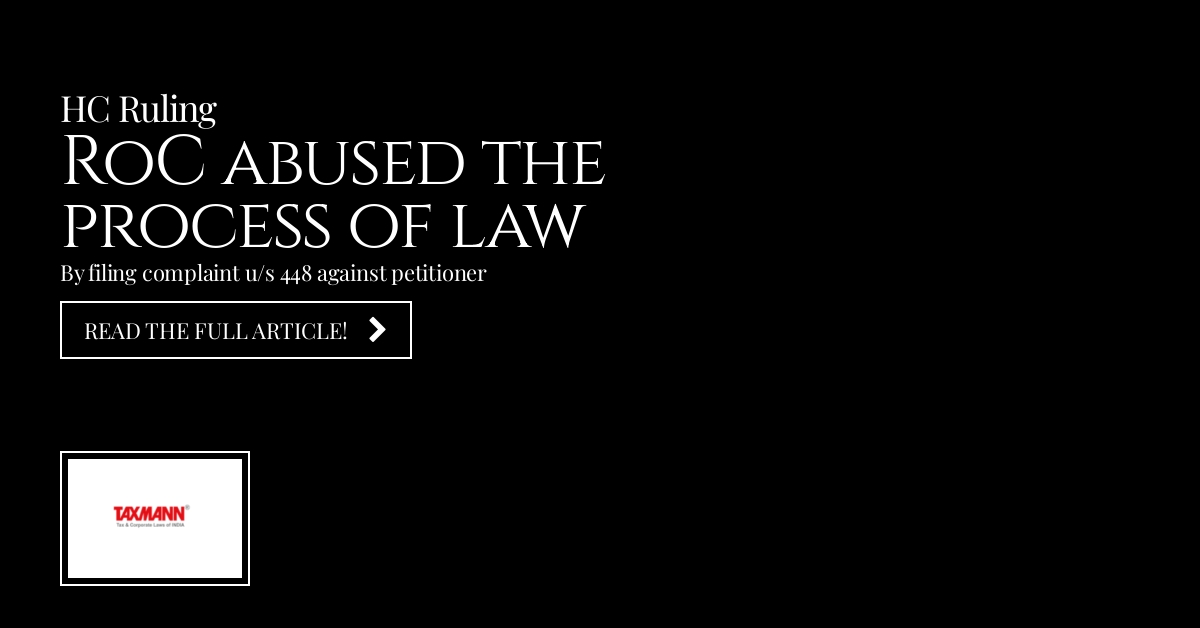RoC abused the process of law by filing complaint u/s 448 against petitioner: HC
- Blog|News|Company Law|
- 2 Min Read
- By Taxmann
- |
- Last Updated on 24 March, 2022
Case Details: Deva Jaya Thanga Thambi v. Deputy Registrar of Companies - [2022] 136 taxmann.com 121 (Madras)
Judiciary and Counsel Details
-
- N. Sathish Kumar, J.
- P. Vasanth for the Petitioner.
- Dr. D. Simon, Central Govt. Standing Counsel for the Respondent.
Facts of the Case
In the instant case, a Petitioner company was inspected by an Inspecting Officer. The Inspecting Officer observed that in the profit and loss account of the petitioner company, it was shown that a sum of Rs. 27.85 crore shown as bad debts, was written off.
The Officer-in-Charge called for complete details of the transactions and break up of parties/debtors. The Officer-in-charger initiated the prosecution offense under section 448 of the Companies Act citing reasons that the reply to the show-cause notice wasn’t satisfactory.
The petitioner-Co. contented that the entire prosecution was nothing but an abuse of process of law and there were no details containing the entire complaint as to the nature of suppression of material facts to attract the offence either under section 447 or 448 of the Companies Act.
It was further contended that the RoC was also aware of the fact that the accounts of the company reflected as bad debts. Therefore, it was observed that the contention of the respondent was not proper. Hence, the petitioner prayed for abashment of the proceedings.
A petition was filed to quash the proceedings filed against the accused for the offence under section 448 of the Companies Act, 2013.
High Court Held
The Madras High Court observed that in order to initiate prosecution either under section 448 or to attract punishment under section 447, there must be a clear finding on record as to fraud or suppression or omission of material facts. However, in instant case at any event, no findings were recorded to show nature of suppression of material facts or omission to state material facts in order to attract provisions of section 447 or 448 and instant prosecution had been filed mainly on the ground that reply notice given by petitioner was not satisfactory. Therefore, it was held that the prosecution of the petitioner was an abuse of the process of law and thus, the same was to be quashed.
Disclaimer: The content/information published on the website is only for general information of the user and shall not be construed as legal advice. While the Taxmann has exercised reasonable efforts to ensure the veracity of information/content published, Taxmann shall be under no liability in any manner whatsoever for incorrect information, if any.

Taxmann Publications has a dedicated in-house Research & Editorial Team. This team consists of a team of Chartered Accountants, Company Secretaries, and Lawyers. This team works under the guidance and supervision of editor-in-chief Mr Rakesh Bhargava.
The Research and Editorial Team is responsible for developing reliable and accurate content for the readers. The team follows the six-sigma approach to achieve the benchmark of zero error in its publications and research platforms. The team ensures that the following publication guidelines are thoroughly followed while developing the content:
- The statutory material is obtained only from the authorized and reliable sources
- All the latest developments in the judicial and legislative fields are covered
- Prepare the analytical write-ups on current, controversial, and important issues to help the readers to understand the concept and its implications
- Every content published by Taxmann is complete, accurate and lucid
- All evidence-based statements are supported with proper reference to Section, Circular No., Notification No. or citations
- The golden rules of grammar, style and consistency are thoroughly followed
- Font and size that’s easy to read and remain consistent across all imprint and digital publications are applied








 CA | CS | CMA
CA | CS | CMA


